
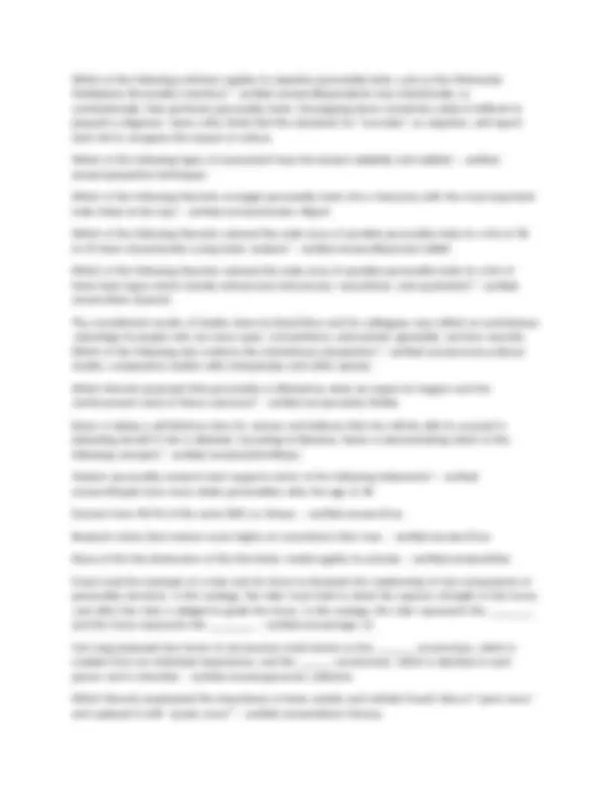
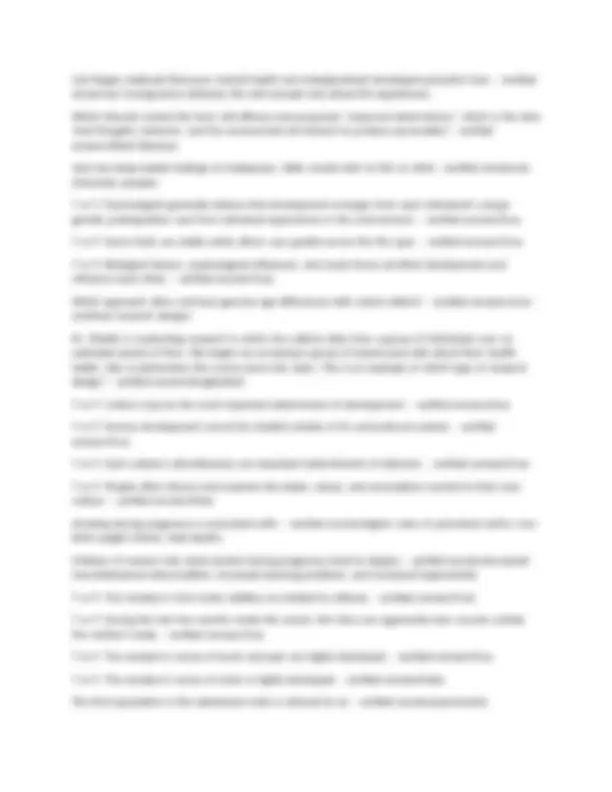
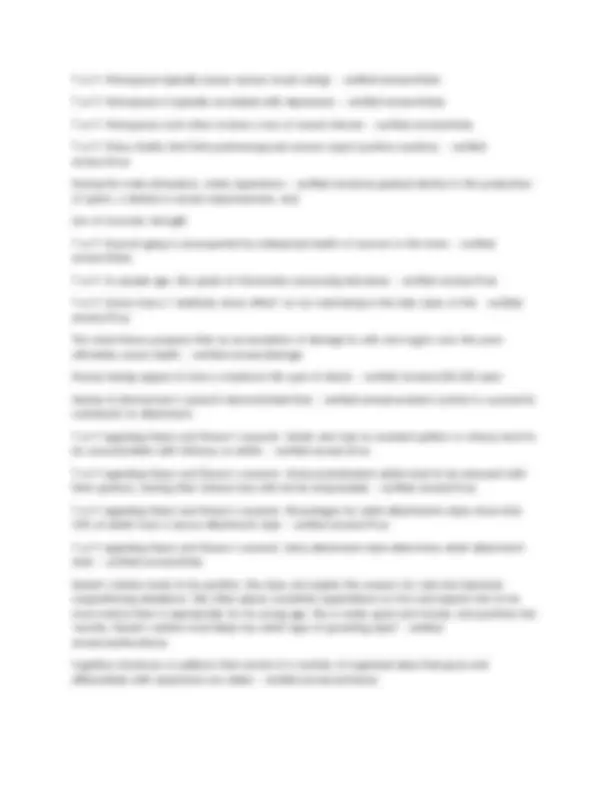
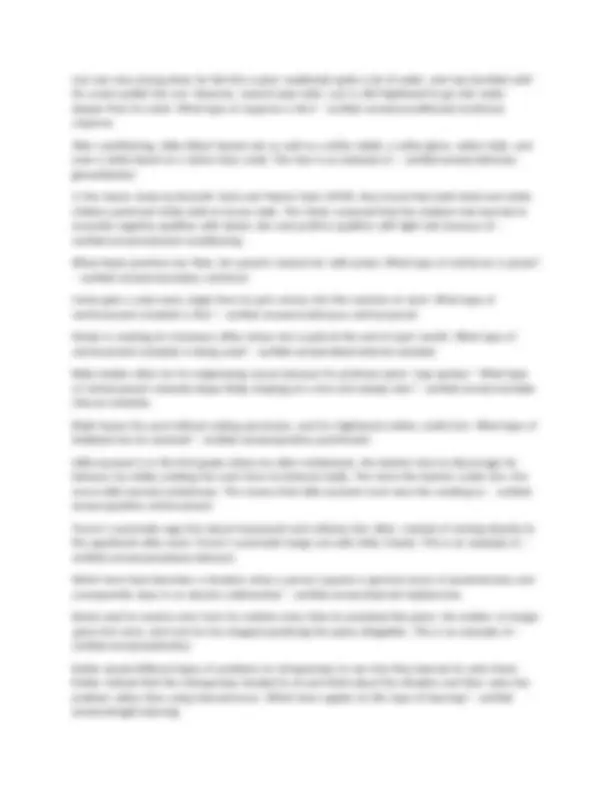
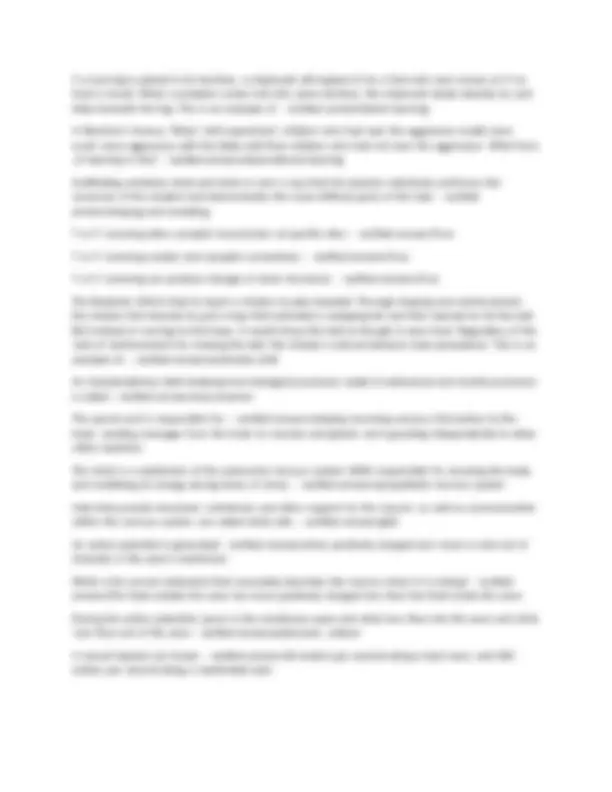
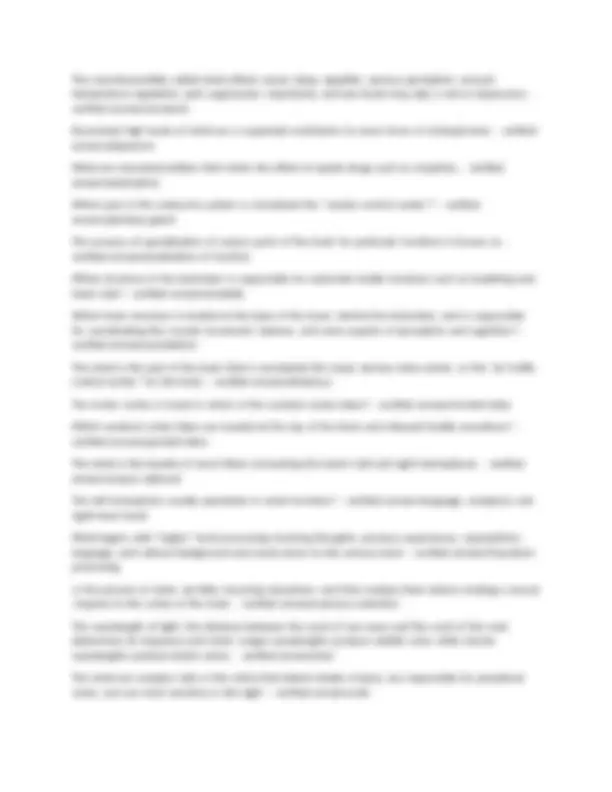
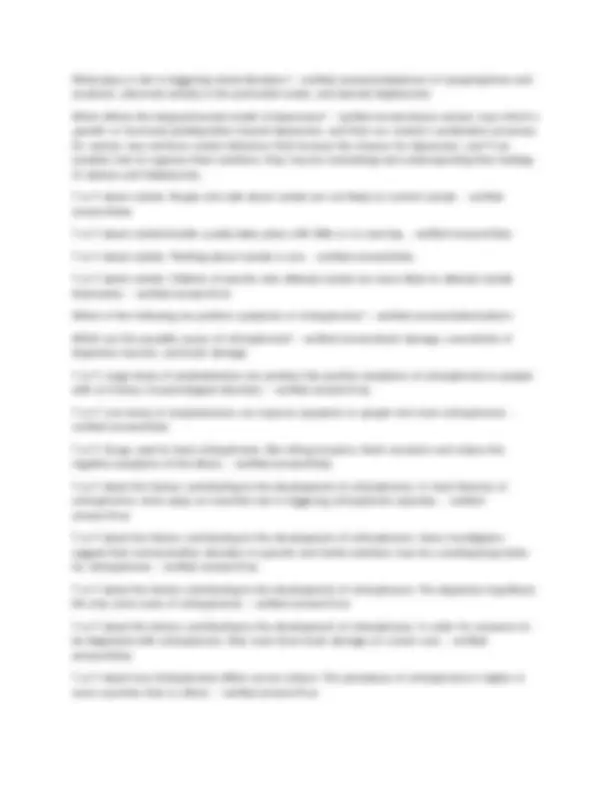
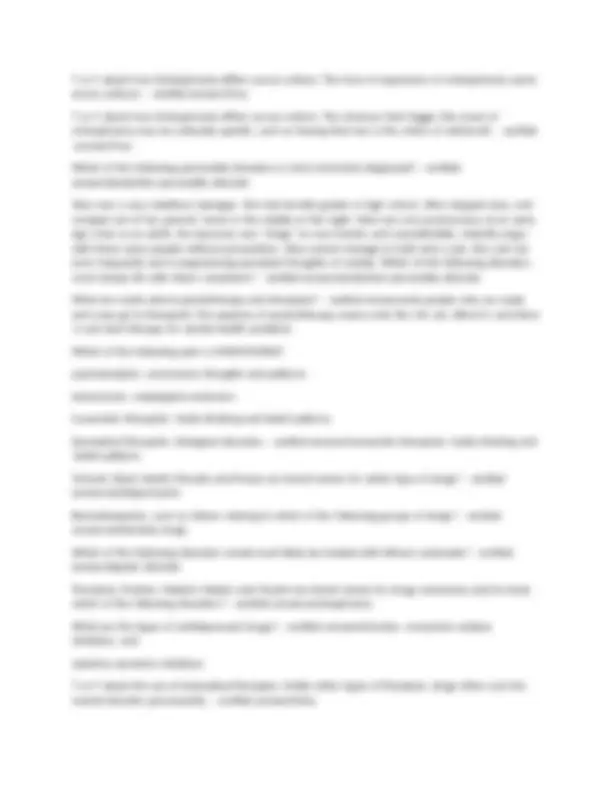
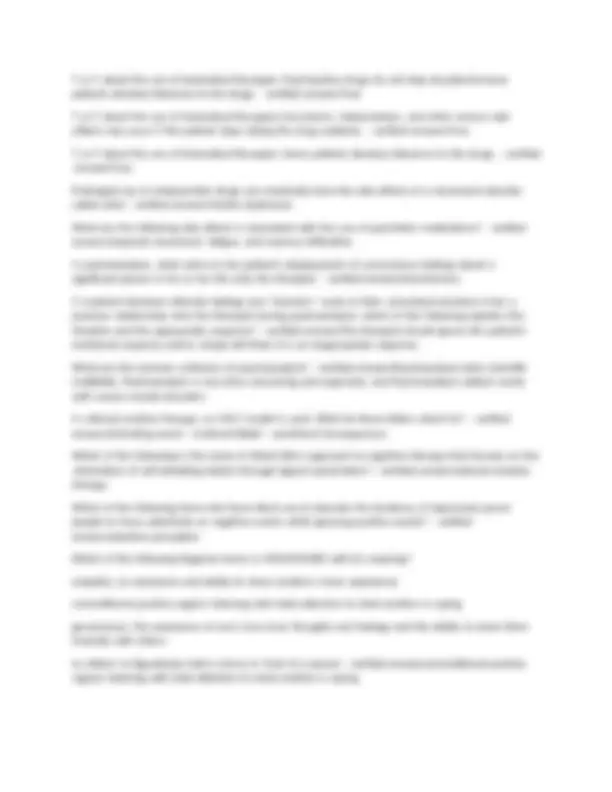
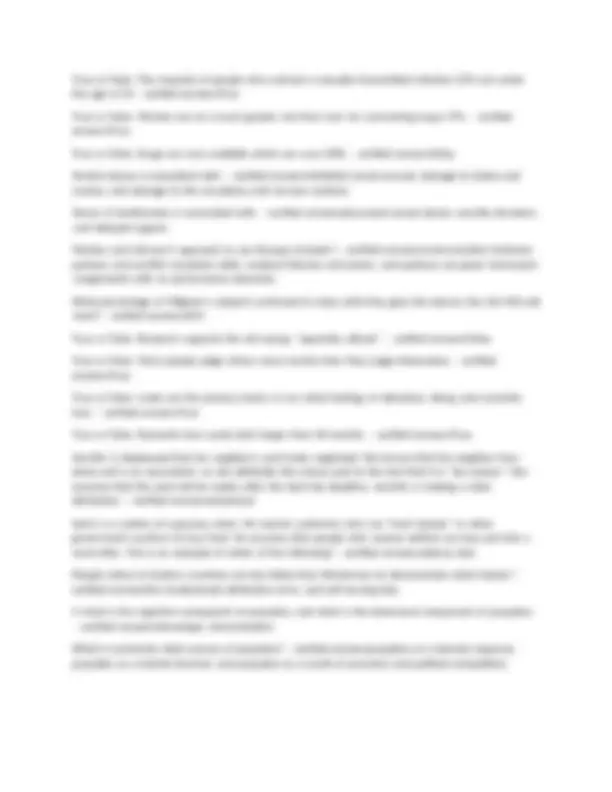
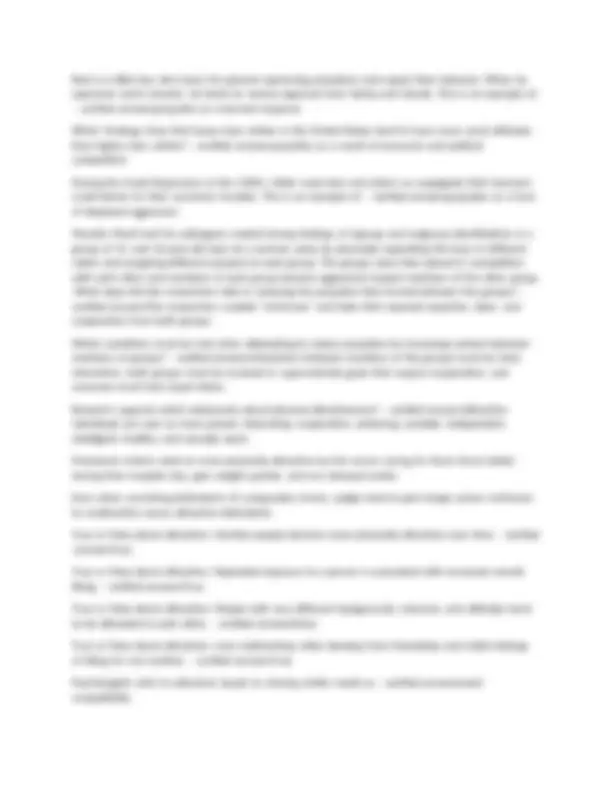
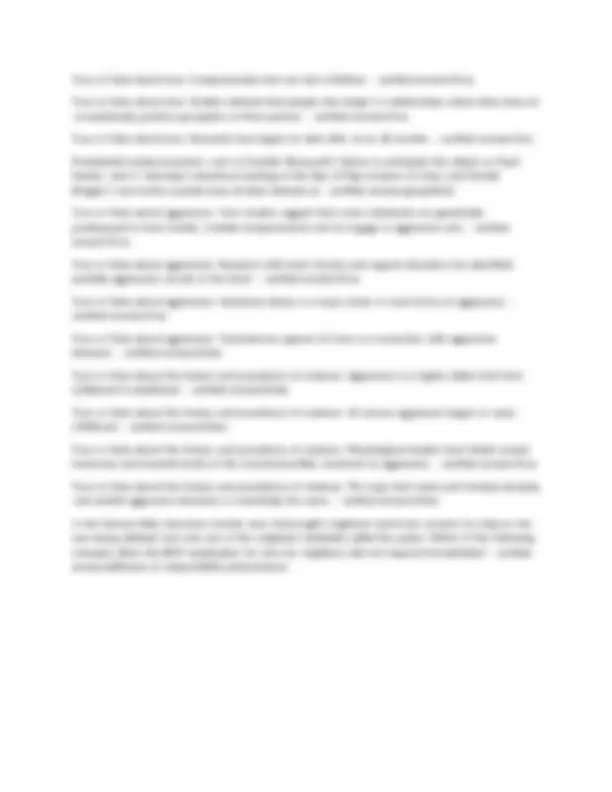


Study with the several resources on Docsity

Earn points by helping other students or get them with a premium plan


Prepare for your exams
Study with the several resources on Docsity

Earn points to download
Earn points by helping other students or get them with a premium plan
Community
Ask the community for help and clear up your study doubts
Discover the best universities in your country according to Docsity users
Free resources
Download our free guides on studying techniques, anxiety management strategies, and thesis advice from Docsity tutors
UCLA Psych 101 Textbook-Based Exam Questions
Typology: Exams
1 / 20

This page cannot be seen from the preview
Don't miss anything!













Which |specialty |in |psychology |focuses |on |the |application |of |the |principles |of |psychology |to |the | workplace, |including |personnel |selection, |leadership, |and |job |satisfaction? |- |verified | answersindustrial/organizational |psychology Dr. |Holloway |is |conducting |research |to |develop |group |exercises |that |will |decrease |the |amount |of | bullying |on |school |playgrounds. |This |type |of |research |is: |- |verified |answersapplied |research An |interrelated |set |of |concepts |which |explains |a |body |of |data |is |called |a |- |verified |answerstheory What |research |involves |the |manipulation |and |control |of |variables |and |attempt |to |identify |cause |and | effect. |- |verified |answersExperimental A |researcher |is |studying |the |use |of |scent |as |a |memory |aid. |One |group |is |asked |to |listen |to |a |series |of |lectures |in |a |room |that |smells |of |oranges |and |later |to |recall |the |information |while |sniffing |the |same | scent. |The |other |group |is |asked |to |listen |to |and |later |to |recall |the |same |information |in |an |identical | room |with |no |particular |odor. |What |is |the |independent |variable? |- |verified |answersthe |scent |of | oranges Dr. |Calef |is |investigating |the |effectiveness |of |the |SQ4R |method |with |general |psychology |students. |He | randomizes |the |students |into |two |groups. |One |group |is |given |instructions |in |how |to |use |the |SQ4R | method |and |is |asked |to |try |the |method. |The |other |group |receives |no |such |instructions. |He |then | compares |the |scores |on |subsequent |exams. |Which |is |the |experimental |group? |- |verified |answersThe | students |that |received |instructions |are |the |experiment |group. When |interviewing |subjects, |Sam |is |unknowingly |giving |subtle |facial |cues |that |influence |the |subjects' | responses |toward |supporting |his |hypothesis. |This |problem |is |referred |to |as: |- |verified | answersexperimenter |bias. In |an |experiment, |both |the |experimenter |administering |the |drug |and |the |participants |taking |the |drug | are |unaware |as |to |who |is |receiving |a |placebo |and |who |is |receiving |the |drug. |This |is |known |as |a: |- | verified |answersdouble-blind |study. Two |researchers, |each |from |a |different |cultural |background, |collaborate |to |conduct |a |research |study | two |times, |once |with |members |of |their |own |culture |and |once |with |members |of |at |least |one |other | culture. |The |cross-cultural |sampling |is |done |specifically |to |avoid: |- |verified |answersthe |bias |of | ethnocentrism. Dr. |DeLoe |separates |his |subjects |into |groups. |Subjects |with |an |even |social |security |number |are |in |the | control |group |and |subjects |with |an |odd |social |security |number |are |in |the |experimental |group. |This | procedure |is |an |example |of: |- |verified |answersrandom |assignment.
Ivy |conceals |herself |behind |a |one-way |mirror |taking |notes |while |watching |children |in |a |pre-school | setting |interact. |She |does |not |manipulate |the |behavior |of |the |children. |This |is |an |example |of: |- | verified |answersnaturalistic |observation. What |are |the |advantages |of |using |the |descriptive |research |methods |instead |of |the |experimental | method? |- |verified |answersDescriptive |research |methods |minimize |artificiality. |Data |is |easier |to | collect |with |descriptive |research |methods. Yuri |conducts |a |descriptive |study |and |finds |that |as |the |number |of |absences |increase |in |psychology | classes, |the |grades |tend |to |decrease. |This |is |an |example |of |a: |- |verified |answersnegative |correlation. A |correlation |coefficient |of |+0.02 |is |found |in |Stacy's |study |of |birth |date |and |the |personality |trait |of | extraversion. |We |can |conclude: |- |verified |answersthat |the |variables |are |likely |to |be |unrelated. John's |doctor |suspects |that |he |may |have |had |a |stroke. |She |sends |John |for |a |procedure |in |which |a | computer |that |creates |cross-sectional |pictures |of |the |brain |reads |x-rays |directed |through |the |brain |at | different |angles. |Which |type |of |brain |scan |is |John |likely |to |have? |- |verified |answersCT |scan What |involves |informing |participants |after |the |research |about |the |purpose |of |the |study, |the |nature |of |the |anticipated |results, |and |any |deception |used. |- |verified |answersDebriefing About |what |percentage |of |psychology |studies |are |done |on |nonhuman |animals? |- |verified |answersonly |about |7-8 |% Under |what |circumstances |may |a |therapist |ethically |violate |confidentiality? |- |verified |answersIn |cases | of |serious |threat |to |others, |information |may |be |divulged. Which |school |of |psychology's |past |used |the |techniques |of |introspection, |the |experimental |method, | and |the |comparative |method |and |placed |major |emphasis |on |applying |psychological |findings |to | practical |situations |and |on |the |function |of |mental |processes |in |adapting |to |the |environment? |- | verified |answersfunctionalism Which |school |of |psychology's |past |emphasized |sexual |and |aggressive |impulses? |- |verified | answerspsychoanalytic Which |of |the |following |types |of |personality |assessments |is |most |often |and |most |widely |used? |- | verified |answersobjective |tests For |what |use |is |the |Minnesota |Multiphasic |Personality |Inventory |(MMPI) |primarily |designed? |- | verified |answersfor |diagnosis |of |psychological |disorders Which |of |the |following |assessments |is |the |most |widely |used |projective |test? |- |verified | answersRorschach |Inkblot |Test At |Harold's |annual |performance |review, |his |boss |is |objective |and |fair |in |critiquing |Harold's | performance. |The |boss |lists |many |of |Harold's |strengths |and |also |offers |constructive |criticism |and | suggestions |for |improvement. |Harold |readily |accepts |the |positive |remarks |and |rejects |the |negative | comments. |He |angrily |states |that |his |boss |"doesn't |know |what |his |is |talking |about" |in |reference |to | the |suggestions |for |improvement. |Harold's |reaction |to |accurate, |constructive |criticism |reflects |which | logical |fallacy? |- |verified |answersthe |fallacy |of |positive |instances
Carl |Rogers |believed |that |poor |mental |health |and |maladjustment |developed |primarily |from: |- |verified | answersan |incongruence |between |the |self-concept |and |actual |life |experiences. Which |theorist |coined |the |term |self-efficacy |and |proposed |"reciprocal |determinism," |which |is |the |idea |that |thoughts, |behavior, |and |the |environment |all |interact |to |produce |personality? |- |verified | answersAlbert |Bandura Jane |has |deep-seated |feelings |of |inadequacy. |Adler |would |refer |to |this |as |what |- |verified |answersan | inferiority |complex T |or |F: |Psychologists |generally |believe |that |development |emerges |from |each |individual's |unique | genetic |predisposition |and |from |individual |experiences |in |the |environment. |- |verified |answersTrue T |or |F: |Some |traits |are |stable |while |others |vary |greatly |across |the |life |span. |- |verified |answersTrue T |or |F: |Biological |factors, |psychological |influences, |and |social |forces |all |affect |development |and | influence |each |other. |- |verified |answersTrue Which |approach |often |confuses |genuine |age |differences |with |cohort |effects? |- |verified |answerscross- sectional |research |designs Dr. |Shields |is |conducting |research |in |which |she |collects |data |from |a |group |of |individuals |over |an | extended |period |of |time. |She |begins |by |surveying |a |group |of |twenty-year-olds |about |their |health | habits. |She |re-administers |the |survey |every |ten |years. |This |is |an |example |of |which |type |of |research | design? |- |verified |answerslongitudinal T |or |F: |Culture |may |be |the |most |important |determinant |of |development. |- |verified |answerstrue T |or |F: |Human |development |cannot |be |studied |outside |of |its |sociocultural |context. |- |verified | answersTrue T |or |F: |Each |culture's |ethnotheories |are |important |determinants |of |behavior. |- |verified |answersTrue T |or |F: |People |often |discuss |and |examine |the |ideals, |values, |and |assumptions |central |to |their |own | culture. |- |verified |answersFalse Smoking |during |pregnancy |is |associated |with: |- |verified |answershigher |rates |of |premature |births, |low- birth-weight |infants, |fetal |deaths Children |of |women |who |drink |alcohol |during |pregnancy |tend |to |display: |- |verified |answersincreased | neurobehavioral |abnormalities, |increased |learning |problems, |and |increased |hyperactivity T |or |F: |The |newborn's |first |motor |abilities |are |limited |to |reflexes. |- |verified |answersTrue T |or |F: |During |the |last |few |months |inside |the |womb, |the |fetus |can |apparently |hear |sounds |outside | the |mother's |body. |- |verified |answersTrue T |or |F: |The |newborn's |sense |of |touch |and |pain |are |highly |developed. |- |verified |answersTrue T |or |F: |The |newborn's |sense |of |vision |is |highly |developed. |- |verified |answersFalse The |first |ejaculation |in |the |adolescent |male |is |referred |to |as: |- |verified |answersspermarche
T |or |F: |Menopause |typically |causes |serious |mood |swings. |- |verified |answersFalse T |or |F: |Menopause |is |typically |correlated |with |depression. |- |verified |answersFalse T |or |F: |Menopause |most |often |involves |a |loss |of |sexual |interest. |- |verified |answersFalse T |or |F: |Many |studies |find |that |postmenopausal |women |report |positive |reactions. |- |verified | answersTrue During |the |male |climacteric, |males |experience: |- |verified |answersa |gradual |decline |in |the |production | of |sperm, |a |decline |in |sexual |responsiveness, |and | loss |of |muscular |strength T |or |F: |Normal |aging |is |accompanied |by |widespread |death |of |neurons |in |the |brain. |- |verified | answersFalse T |or |F: |As |people |age, |the |speed |of |information |processing |decreases. |- |verified |answersTrue T |or |F: |Genes |have |a |"relatively |minor |effect" |on |our |well |being |in |the |later |years |of |life. |- |verified | answersTrue The |what |theory |proposes |that |an |accumulation |of |damage |to |cells |and |organs |over |the |years | ultimately |causes |death. |- |verified |answersdamage Human |beings |appear |to |have |a |maximum |life |span |of |about: |- |verified |answers110-120 |years Harlow |& |Zimmerman's |research |demonstrated |that: |- |verified |answerscontact |comfort |is |a |powerful | contributor |to |attachment. T |or |F |regarding |Hazan |and |Shaver's |research: |Adults |who |had |an |avoidant |pattern |in |infancy |tend |to | be |uncomfortable |with |intimacy |as |adults. |- |verified |answersTrue T |or |F |regarding |Hazan |and |Shaver's |research: |Anxious/ambivalent |adults |tend |to |be |obsessed |with | their |partners, |fearing |their |intense |love |will |not |be |reciprocated. |- |verified |answersTrue T |or |F |regarding |Hazan |and |Shaver's |research: |Percentages |for |adult |attachments |styles |show |that | 55% |of |adults |have |a |secure |attachment |style. |- |verified |answersTrue T |or |F |regarding |Hazan |and |Shaver's |research: |Early |attachment |style |determines |adult |attachment | style. |- |verified |answersFalse Daniel's |mother |tends |to |be |punitive. |She |does |not |explain |the |reasons |for |rules |but |demands | unquestioning |obedience. |She |often |places |unrealistic |expectations |on |him |and |expects |him |to |be | more |mature |than |is |appropriate |for |his |young |age. |She |is |easily |upset |and |moody, |and |punishes |him |harshly. |Daniel's |mother |most |likely |has |which |type |of |parenting |style? |- |verified | answersauthoritarian Cognitive |structures |or |patterns |that |consist |of |a |number |of |organized |ideas |that |grow |and | differentiate |with |experience |are |called: |- |verified |answersschemas
some |of |her |time |to |working |with |high-risk |children |through |a |community |agency. |She |is |most |likely | in |which |of |Erikson's |stages? |- |verified |answersgenerativity |versus |stagnation T |or |F: |Adolescence |is |the |most |stressful |period |in |the |lifespan. |- |verified |answersTrue T |or |F: |Some |researchers |find |that |divorce |has |little |or |no |effect |on |children's |behavioral |and |social | problems. |- |verified |answersTrue T |or |F: |When |the |last |child |leaves |home, |it |is |a |usually |a |time |of |despair |and |crisis |for |the |parents | and |marital |satisfaction |typically |decreases. |- |verified |answersFalse T |or |F: |Abuse |and |violence |within |the |home |occurs |at |all |socioeconomic |levels. |- |verified |answersTrue T |or |F: |One |of |the |clearest |identifiers |of |abuse |potential |is |impulsivity. |- |verified |answersTrue T |or |F: |Alcoholism |has |been |linked |to |aggressive |outbursts. |- |verified |answersTrue Which |areas |of |the |brain |are |closely |related |to |the |expression |and |control |of |aggression? |- |verified | answersamygdala, |prefrontal |cortex, |and |hypothalamus Which |hormone |levels |have |been |associated |with |irritability, |hypersensitivity |to |provocation, |and | impulsive |rage? |- |verified |answerslow |levels |of |serotonin T |or |F: |Younger |couples |have |higher |divorce |rates |than |older |couples. |- |verified |answersTrue T |or |F: |Divorce |is |higher |among |the |poor |and |unemployed. |- |verified |answersTrue T |or |F: |Divorce |is |higher |among |adult |children |of |divorced |parents. |- |verified |answersTrue T |or |F: |Couples |with |"opposite" |values |and |beliefs |have |longer |lasting |relationships. |- |verified | answersFalse Which |theory |states |that |a |fulfilling |old |age |comes |from |remaining |active |and |involved |as |long |as | possible? |- |verified |answersactivity |theory |of |aging Which |of |the |following |basic |concepts |associated |with |death |do |children |tend |to |understand |first |and |most |easily? |- |verified |answerspermanence By |what |age |have |most |children |developed |an |adult-like |understanding |of |death? |- |verified | answersseven |years |old Margaret |realizes |that |she |is |terminally |ill |and |tells |God |that |she |will |be |an |ideal |servant |if |he |will |let | her |live |to |see |her |grandchild's |birth. |Which |stage |of |Kubler-Ross's |theory |is |Margaret |most |likely | experiencing? |- |verified |answersbargaining In |Pavlov's |famous |experiment |with |the |salivating |dogs, |what |was |the |unconditioned |stimulus |(UCS)? |- |verified |answersfood Susan |is |having |chemotherapy |treatments |that |make |her |very |nauseous. |After |coming |to |the |clinic |for |several |treatments, |she |begins |to |feel |nauseous |in |the |waiting |room |even |before |the |treatment |is | administered. |What |is |the |conditioned |response |(CR)? |- |verified |answersnausea |in |response |to |the | waiting |room
Luis |was |very |young |when |he |fell |into |a |pool, |swallowed |quite |a |lot |of |water, |and |was |terrified |until | his |cousin |pulled |him |out. |However, |several |years |later, |Luis |is |still |frightened |to |go |into |water | deeper |than |his |waist. |What |type |of |response |is |this? |- |verified |answersconditioned |emotional | response After |conditioning, |Little |Albert |feared |rats |as |well |as |a |white |rabbit, |a |white |glove, |cotton |balls, |and | even |a |white |beard |on |a |Santa |Claus |mask. |This |fear |is |an |example |of: |- |verified |answersstimulus | generalization In |the |classic |study |by |Kenneth |Clark |and |Mamie |Clark |(1939), |they |found |that |both |black |and |white | children |preferred |white |dolls |to |brown |dolls. |The |Clarks |reasoned |that |the |children |had |learned |to | associate |negative |qualities |with |darker |skin |and |positive |qualities |with |light |skin |because |of: |- | verified |answersclassical |conditioning. When |Kayla |practices |her |flute, |her |parents |reward |her |with |praise. |What |type |of |reinforcer |is |praise? |- |verified |answerssecondary |reinforcer Carlos |gets |a |soda |every |single |time |he |puts |money |into |the |machine |at |work. |What |type |of | reinforcement |schedule |is |this? |- |verified |answerscontinuous |reinforcement Hiroko |is |working |at |a |business |office |where |she |is |paid |at |the |end |of |each |month. |What |type |of | reinforcement |schedule |is |being |used? |- |verified |answersfixed |interval |schedule Rafiq |studies |often |for |his |engineering |course |because |his |professor |gives |"pop |quizzes." |What |type | of |reinforcement |schedule |keeps |Rafiq |studying |at |a |slow |and |steady |rate? |- |verified |answersvariable | interval |schedule Elijah |leaves |the |yard |without |asking |permission, |and |his |frightened |mother |scolds |him. |What |type |of | feedback |has |he |received? |- |verified |answerspositive |punishment Little |Leonard |is |in |the |first |grade |where |he |often |misbehaves. |His |teacher |tries |to |discourage |his | behavior |by |mildly |scolding |him |each |time |he |behaves |badly. |The |more |the |teacher |scolds |him; |the | more |Little |Leonard |misbehaves. |This |means |that |Little |Leonard |must |view |the |scolding |as: |- |verified | answerspositive |reinforcement Trevor's |roommate |nags |him |about |housework |and |criticizes |him |often. |Instead |of |coming |directly |to | the |apartment |after |work, |Trevor's |roommate |hangs |out |with |other |friends. |This |is |an |example |of: |- | verified |answersavoidance |behavior. Which |term |best |describes |a |situation |when |a |person |acquires |a |general |sense |of |powerlessness |and | consequently |stays |in |an |abusive |relationship? |- |verified |answerslearned |helplessness Derek |used |to |receive |coins |from |his |mother |every |time |he |practiced |the |piano. |His |mother |no |longer |gives |him |coins, |and |now |he |has |stopped |practicing |the |piano |altogether. |This |is |an |example |of: |- | verified |answersextinction Kohler |posed |different |types |of |problems |to |chimpanzees |to |see |how |they |learned |to |solve |them. | Kohler |noticed |that |the |chimpanzees |tended |to |sit |and |think |about |the |situation |and |then |solve |the | problem |rather |than |using |trial-and-error. |Which |term |applies |to |this |type |of |learning? |- |verified | answersinsight |learning
The |neurotransmitter |called |what |affects |mood, |sleep, |appetite, |sensory |perception, |arousal, | temperature |regulation, |pain |suppression, |impulsivity, |and |low |levels |may |play |a |role |in |depression. |- | verified |answersserotonin Excessively |high |levels |of |what |are |a |suspected |contributor |to |some |forms |of |schizophrenia. |- |verified | answersdopamine What |are |neurotransmitters |that |mimic |the |effect |of |opiate |drugs |such |as |morphine. |- |verified | answersendorphins Which |part |of |the |endocrine |system |is |considered |the |"master |control |center"? |- |verified | answerspituitary |gland The |process |of |specialization |of |various |parts |of |the |brain |for |particular |functions |is |known |as |- | verified |answerslocalization |of |function Which |structure |in |the |brainstem |is |responsible |for |automatic |bodily |functions |such |as |breathing |and | heart |rate? |- |verified |answersmedulla Which |brain |structure |is |located |at |the |base |of |the |brain, |behind |the |brainstem, |and |is |responsible | for |coordinating |fine |muscle |movement, |balance, |and |some |aspects |of |perception |and |cognition? |- | verified |answerscerebellum The |what |is |the |part |of |the |brain |that |is |considered |the |major |sensory |relay |center, |or |the |"air |traffic | control |center" |for |the |brain. |- |verified |answersthalamus The |motor |cortex |is |found |in |which |of |the |cerebral |cortex |lobes? |- |verified |answersfrontal |lobes Which |cerebral |cortex |lobes |are |located |at |the |top |of |the |brain |and |interpret |bodily |sensations? |- | verified |answersparietal |lobes The |what |is |the |bundle |of |nerve |fibers |connecting |the |brain's |left |and |right |hemispheres. |- |verified | answerscorpus |callosum The |left |hemisphere |usually |specializes |in |what |functions? |- |verified |answerslanguage, |analytical, |and | right-hand |touch What |begins |with |"higher" |level |processing |involving |thoughts, |previous |experiences, |expectations, | language, |and |cultural |background |and |works |down |to |the |sensory |level. |- |verified |answersTop-down | processing In |the |process |of |what, |we |filter |incoming |sensations, |and |then |analyze |them |before |sending |a |neural |impulse |to |the |cortex |of |the |brain. |- |verified |answerssensory |reduction The |wavelength |of |light, |the |distance |between |the |crest |of |one |wave |and |the |crest |of |the |next, | determines |its |frequency |and |what. |Longer |wavelengths |produce |reddish |color |while |shorter | wavelengths |produce |bluish |colors. |- |verified |answershue The |what |are |receptor |cells |in |the |retina |that |detect |shades |of |gray, |are |responsible |for |peripheral | vision, |and |are |most |sensitive |in |dim |light. |- |verified |answersrods
Located |in |the |center |of |the |retina, |the |what |is |a |tiny |pit |filled |with |cones |that |is |responsible |for | sharp |vision. |- |verified |answersfovea Wavelengths |in |light |correspond |to |color |while |wavelengths |in |sound |correspond |to |- |verified | answerspitch What |theory |explains |how |we |hear |higher-pitched |sounds. |Different |high-pitched |sounds |bend |the | basilar |membrane |hair |cells |at |different |locations |in |the |cochlea. |- |verified |answersPlace When |chemical |molecules |in |the |air |pass |through |the |nose |and |come |into |contact |with |the |dendrites | of |the |olfactory |receptors |embedded |in |the |olfactory |epithelium, |they |initiate |a |neural |impulse. |The | impulse |travels |along |the |neuron's |axon |directly |to |the |what, |where |most |olfactory |information |is | processed. |- |verified |answersolfactory |bulb What |sense |is |the |sensory |system |for |body |posture |and |orientation. |- |verified |answersKinesthesia A(n) |what |is |a |false |impression |of |the |physical |world |that |can |be |produced |by |actual |physical | distortions |or |by |errors |in |the |perceptual |process. |- |verified |answersillusion Looking |over |a |field |of |sunflowers, |Tashia |judges |the |rows |having |greater |detail |as |being |closer |to | her. |This |is |an |example |of: |- |verified |answerstexture |gradient. Which |basic |Gestalt |principle |of |organization |states |that |objects |that |are |physically |close |together |are |grouped |together? |- |verified |answersproximity What |is |the |tendency |for |the |environment |to |be |perceived |as |remaining |the |same |in |spite |of |changes |in |sensory |input. |- |verified |answersPerceptual |constancy Anthropologist |Colin |Turnbull |(1961) |provided |a |classic |example |of |an |adult |who |had |never |developed |a |sense |of |what. |His |subject |had |lived |in |a |rain |forest |so |dense |that |he |had |never |seen |further |than | about | 100 |yards. |When |the |subject |first |saw |a |herd |of |water |buffalo |in |the |distance, |he |thought |they | were |insects. |As |they |drove |toward |the |"insects," |they |seemed |to |"grow" |into |buffalo. |- |verified | answerssize |constancy What |allows |us |to |accurately |estimate |the |distance |of |perceived |objects |and |thereby |to |perceive |the | world |in |three |dimensions. |- |verified |answersDepth |perception What |is |a |binocular |cue |to |distance |in |which |separation |of |the |eyes |causes |different |images |to |fall |on |each |retina. |- |verified |answersRetinal |disparity What |is |a |binocular |depth |cue |in |which |the |eyes |turn |inward |as |objects |move |closer. |The |amount |of | strain |in |the |eye |muscles |is |used |as |a |cue |by |the |brain |to |interpret |distance. |- |verified | answersConvergence What |refers |to |the |fact |that |when |an |observer |is |moving, |objects |at |various |distances |move |at | different |speeds |across |the |retinal |field. |Close |objects |appear |to |whiz |by, |farther |objects |seem |to | move |slowly, |and |distant |objects |appear |to |remain |stationary. |- |verified |answersMotion |parallax What |is |Young's |theory |that |color |perception |results |from |mixing |three |distinct |color |systems |- |red, | green, |and |blue. |- |verified |answersTrichromatic |theory
What |plays |a |role |in |triggering |mood |disorders? |- |verified |answersimbalances |of |norepinephrine |and | serotonin, |abnormal |activity |in |the |prefrontal |cortex, |and |learned |helplessness What |reflects |the |biopsychosocial |model |of |depression? |- |verified |answersSome |women |may |inherit |a |genetic |or |hormonal |predisposition |toward |depression, |and |then |our |society's |socialization |processes | for |women |may |reinforce |certain |behaviors |that |increase |the |chances |for |depression, |and |If |we | socialize |men |to |suppress |their |emotions, |they |may |be |overlooking |and |underreporting |their |feelings | of |sadness |and |helplessness. T |or |F |about |suicide: |People |who |talk |about |suicide |are |not |likely |to |commit |suicide. |- |verified | answersFalse T |or |F |about |suicide:Suicide |usually |takes |place |with |little |or |no |warning. |- |verified |answersFalse T |or |F |about |suicide: |Thinking |about |suicide |is |rare. |- |verified |answersFalse T |or |F |about |suicide: |Children |of |parents |who |attempt |suicide |are |more |likely |to |attempt |suicide | themselves. |- |verified |answersTrue Which |of |the |following |are |positive |symptoms |of |schizophrenia? |- |verified |answershallucinations Which |are |the |possible |causes |of |schizophrenia? |- |verified |answersbrain |damage, |overactivity |of | dopamine |neurons, |and |brain |damage T |or |F: |Large |doses |of |amphetamines |can |produce |the |positive |symptoms |of |schizophrenia |in |people | with |no |history |of |psychological |disorders. |- |verified |answersTrue T |or |F: |Low |doses |of |amphetamines |can |improve |symptoms |in |people |who |have |schizophrenia. |- | verified |answersFalse T |or |F: |Drugs |used |to |treat |schizophrenia, |like |chlorpromazine, |block |serotonin |and |reduce |the | negative |symptoms |of |the |illness. |- |verified |answersFalse T |or |F |about |the |factors |contributing |to |the |development |of |schizophrenia: |In |most |theories |of | schizophrenia, |stress |plays |an |essential |role |in |triggering |schizophrenic |episodes. |- |verified | answersTrue T |or |F |about |the |factors |contributing |to |the |development |of |schizophrenia: |Some |investigators | suggest |that |communication |disorders |in |parents |and |family |members |may |be |a |predisposing |factor | for |schizophrenia. |- |verified |answersTrue T |or |F |about |the |factors |contributing |to |the |development |of |schizophrenia: |The |dopamine |hypothesis | fits |only |some |cases |of |schizophrenia. |- |verified |answersTrue T |or |F |about |the |factors |contributing |to |the |development |of |schizophrenia: |In |order |for |someone |to | be |diagnosed |with |schizophrenia, |they |must |show |brain |damage |on |a |brain |scan. |- |verified | answersFalse T |or |F |about |how |Schizophrenia |differs |across |culture: |The |prevalence |of |schizophrenia |is |higher |in | some |countries |than |in |others. |- |verified |answersTrue
T |or |F |about |how |Schizophrenia |differs |across |culture: |The |form |of |expression |of |schizophrenia |varies | across |cultures. |- |verified |answersTrue T |or |F |about |how |Schizophrenia |differs |across |culture: |The |stressors |that |trigger |the |onset |of | schizophrenia |may |be |culturally |specific, |such |as |fearing |that |one |is |the |victim |of |witchcraft. |- |verified |answersTrue Which |of |the |following |personality |disorders |is |most |commonly |diagnosed? |- |verified | answersborderline |personality |disorder Alice |was |a |very |rebellious |teenager. |She |had |terrible |grades |in |high |school, |often |skipped |class, |and | sneaked |out |of |her |parents' |home |in |the |middle |of |the |night. |Alice |was |very |promiscuous |at |an |early | age. |Even |as |an |adult, |she |becomes |very |"clingy" |to |new |friends, |and |unpredictably, |violently |angry | with |these |same |people |without |provocation. |Alice |cannot |manage |to |hold |onto |a |job. |She |cuts |her | arms |frequently |and |is |experiencing |persistent |thoughts |of |suicide. |Which |of |the |following |disorders | most |closely |fits |with |Alice's |symptoms? |- |verified |answersborderline |personality |disorder What |are |myths |about |psychotherapy |and |therapists? |- |verified |answersonly |people |who |are |weak | and |crazy |go |to |therapists, |the |expense |of |psychotherapy |means |only |the |rich |can |afford |it, |and |there |is |one |best |therapy |for |mental |health |problems Which |of |the |following |pairs |is |MISMATCHED? | psychoanalysts: |unconscious |thoughts |and |patterns behaviorists: |maladaptive |behaviors humanistic |therapists: |faulty |thinking |and |belief |patterns biomedical |therapists: |biological |disorders |- |verified |answershumanistic |therapists: |faulty |thinking |and |belief |patterns Tofranil, |Elavil, |Nardil, |Parnate |and |Prozac |are |brand |names |for |which |type |of |drugs? |- |verified | answersantidepressants Benzodiazepines, |such |as |Valium, |belong |to |which |of |the |following |groups |of |drugs? |- |verified | answersantianxiety |drugs Which |of |the |following |disorders |would |most |likely |be |treated |with |lithium |carbonate? |- |verified | answersbipolar |disorder Thorazine, |Prolixin, |Mellaril, |Haldol, |and |Clozaril |are |brand |names |for |drugs |commonly |used |to |treat | which |of |the |following |disorders? |- |verified |answersschizophrenia What |are |the |types |of |antidepressant |drugs? |- |verified |answerstricyclics, |monamine |oxidase | inhibitors, |and | selective |serotonin |inhibitors T |or |F |about |the |use |of |biomedical |therapies: |Unlike |other |types |of |therapies, |drugs |often |cure |the | mental |disorder |permanently. |- |verified |answersFalse
Which |of |the |following |settings |seems |to |be |the |most |favorable |setting |for |the |treatment |of |teen | delinquency? |- |verified |answersfamily |therapy Therapies |in |what |cultures |emphasize |the |self |and |control |over |one's |life |whereas |therapies |in |what | cultures |emphasize |interdependence. |- |verified |answersindividualistic; |collectivist True |or |False |about |therapy |and |gender: |Women |are |more |likely |to |be |victims |of |rape, |incest, |and | sexual |harassment |than |are |men. |- |verified |answersTrue True |or |False |about |therapy |and |gender: |Women |do |not |live |as |long |as |men |do. |- |verified | answersFalse True |or |False |about |therapy |and |gender: |Women |bring |special |challenges |to |therapy |because |they | are |overrepresented |in |the |lowest |economic |groups. |- |verified |answersTrue True |or |False |about |therapy |and |gender: | Research |has |found |that |women |are |diagnosed |and |treated |for |mental |illness |at |a |much |higher |rate | than |men |are. |- |verified |answersTrue Transvestites |are |usually: |- |verified |answersheterosexual |men. Differences |in |the |brains |of |men |and |women |are |apparent |in |which |area(s)? |- |verified | answershypothalamus, |corpus |callosum, | and |cerebral |hemispheres Which |of |the |following |brain |areas |causes |men |to |have |a |relatively |constant |level |of |sex |hormones | and |women |to |have |cyclic |sex |hormone |production |and |menstrual |cycles? |- |verified | answershypothalamus Reported |sex |differences |in |verbal |and |spatial |skills |may, |at |least |in |part, |be |due |to |differences |in |the | male |and |female: |- |verified |answerscerebral |hemispheres True |or |False: |Females |tend |to |score |higher |than |males |on |tests |of |math |abilities. |- |verified | answersFalse True |or |False: |Males |are |more |likely |than |females |to |commit |aggressive |crimes |after |puberty. |- | verified |answersTrue True |or |False: |Males |tend |to |score |higher |than |females |on |tests |of |verbal |abilities. |- |verified | answersFalse True |or |False: |The |breakfast |cereal |Kellogg's |Corn |Flakes |was |originally |developed |to |discourage | masturbation. |- |verified |answersTrue True |or |False: |The |American |Academy |of |Pediatrics |no |longer |recommends |routine |circumcision |for | male |babies. |- |verified |answersTrue True |or |False: |Sexual |skill |and |satisfaction |are |learned |behaviors |that |can |be |increased |through | education |and |training. |- |verified |answersTrue
True |or |False: |The |American |Psychiatric |Association |and |the |American |Psychological |Association | consider |homosexuality |a |type |of |mental |illness. |- |verified |answersFalse Despite |the |repression |of |Victorian |times, |which |of |the |following |researchers |was |among |the |first |to | study |human |sexuality |and |initially |based |his |research |on |his |own |personal |desires? |- |verified | answersHavelock |Ellis In |what |order |do |the |phases |of |the |Masters |and |Johnson's |sexual |response |cycle |occur? |- |verified | answersexcitement |phase |- |plateau |phase |- |orgasm |phase |- |resolution |phase Which |theory |suggests |that |men |have |a |greater |interest |in |sex |and |multiple |partners |and |are |sexually |jealous |because |these |behaviors |maximize |their |chances |for |reproduction? |- |verified |answerssexual | strategies |theory In |at |least | 18 |societies |around |the |world, |female |nonmonogamy |is |the |norm. |People |in |these |cultures |believe |in |a |child |having |more |than |one |biological |father, |and |pregnant |women |openly |acknowledge | their |extramarital |lovers |as |"secondary |fathers." |This |belief |that |multiple |men |contribute |to |the |initial |impregnation |and |later |"building |of |the |child" |is |termed: |, |- |verified |answerspartible |paternity True |or |False |about |the |cause |of |homosexuality: |A |genetic |predisposition |toward |homosexuality |is | supported |by |studies |of |identical |male |and |female |twins, |fraternal |twins, |and |adopted |siblings. |- | verified |answersTrue True |or |False |about |the |cause |of |homosexuality: |Some |researchers |have |hypothesized |that |prenatal | hormone |levels |affect |fetal |brain |development |and |sexual |orientation |in |both |humans |and |animals. |- | verified |answersTrue True |or |False |about |the |cause |of |homosexuality: |Studies |have |shown |differences |in |the |adult | hormones |levels |between |heterosexual |men |and |gay |men. |- |verified |answersFalse Male |impotence |(erectile |dysfunction) |can |be |caused |by: |- |verified |answersdiabetes, |alcohol | consumption, |and |severe |antisexual |upbringing Orgasmic |dysfunction |can |be |caused |by: |- |verified |answerschronic |illness, |alcohol |consumption, |and | childhood |sexual |abuse Vaginismus |is |most |likely |caused |by: |- |verified |answersa |learned |association |of |pain |or |fear |with | intercourse. True |or |False: |The |parasympathetic |nervous |system |must |be |dominant |for |sexual |arousal |to |occur. |- | verified |answersTrue True |or |False: |The |sympathetic |nervous |system |must |be |dominant |for |orgasm |to |occur. |- |verified | answersTrue True |or |False: |Some |aspects |of |sexual |arousal |are |partly |reflexive |while |others |are |learned. |- |verified | answersTrue The |fear |of |being |judged |in |connection |with |sexual |activity |is |called: |- |verified |answersperformance | anxiety
Raul |is |a |little |boy |who |hears |his |parents |expressing |prejudices |and |copies |their |behavior. |When |he | expresses |racist |remarks, |he |tends |to |receive |approval |from |family |and |friends. |This |is |an |example |of: |- |verified |answersprejudice |as |a |learned |response What |i |findings |show |that |lower-class |whites |in |the |United |States |tend |to |have |more |racist |attitudes | than |higher-class |whites? |- |verified |answersprejudice |as |a |result |of |economic |and |political | competition During |the |Great |Depression |of |the |1930's, |Hitler |used |Jews |and |others |as |scapegoats |that |Germans | could |blame |for |their |economic |troubles. |This |is |an |example |of: |- |verified |answersprejudice |as |a |form | of |displaced |aggression. Muzafer |Sherif |and |his |colleagues |created |strong |feelings |of |ingroup |and |outgroup |identification |in |a | group |of |11- |and |12-year-old |boys |at |a |summer |camp |by |physically |separating |the |boys |in |different | cabins |and |assigning |different |projects |to |each |group. |The |groups |were |then |placed |in |competition | with |each |other |and |members |of |each |group |became |aggressive |toward |members |of |the |other |group. |What |steps |did |the |researchers |take |in |reducing |the |prejudice |that |formed |between |the |groups? |- | verified |answersThe |researchers |created |"minicrises" |and |tasks |that |required |expertise, |labor, |and | cooperation |from |both |groups. Which |conditions |must |be |met |when |attempting |to |reduce |prejudice |by |increasing |contact |between | members |of |groups? |- |verified |answersInteraction |between |members |of |the |groups |must |be |close | interaction, |both |groups |must |be |involved |in |superordinate |goals |that |require |cooperation, |and | everyone |must |have |equal |status. Research |supports |which |statements |about |physical |attractiveness? |- |verified |answersAttractive | individuals |are |seen |as |more |poised, |interesting, |cooperative, |achieving, |sociable, |independent, | intelligent, |healthy, |and |sexually |warm. | Premature |infants |rated |as |more |physically |attractive |by |the |nurses |caring |for |them |thrive |better | during |their |hospital |stay, |gain |weight |quicker, |and |are |released |earlier. | Even |when |convicting |defendants |of |comparable |crimes, |judges |tend |to |give |longer |prison |sentences | to |unattractive |versus |attractive |defendants. True |or |False |about |attraction: |Familiar |people |become |more |physically |attractive |over |time. |- |verified |answersTrue True |or |False |about |attraction: |Repeated |exposure |to |a |person |is |associated |with |increased |overall | liking. |- |verified |answersTrue True |or |False |about |attraction: |People |with |very |different |backgrounds, |interests, |and |attitudes |tend | to |be |attracted |to |each |other. |- |verified |answersFalse True |or |False |about |attraction: |Love |relationships |often |develop |from |friendships |and |initial |feelings | of |liking |for |one |another. |- |verified |answersTrue Psychologists |refer |to |attraction |based |on |sharing |similar |needs |as |- |verified |answersneed | compatibility
True |or |False |about |love: |Compassionate |love |can |last |a |lifetime. |- |verified |answersTrue True |or |False |about |love: |Studies |indicate |that |people |stay |longer |in |relationships |where |they |have |an |unrealistically |positive |perception |of |their |partner. |- |verified |answersTrue True |or |False |about |love: |Romantic |love |begins |to |fade |after |six |to | 30 |months. |- |verified |answersTue Presidential |embarrassments, |such |as |Franklin |Roosevelt's |failure |to |anticipate |the |attack |on |Pearl | Harbor, |John |F. |Kennedy's |disastrous |backing |of |the |Bay |of |Pigs |invasion |of |Cuba, |and |Ronald | Reagan's |Iran-Contra |scandal |have |all |been |blamed |on |- |verified |answersgroupthink True |or |False |about |aggression: |Twin |studies |suggest |that |some |individuals |are |genetically | predisposed |to |have |hostile, |irritable |temperaments |and |to |engage |in |aggressive |acts. |- |verified | answersTrue True |or |False |about |aggression: |Research |with |brain |injuries |and |organic |disorders |has |identified | possible |aggression |circuits |in |the |brain. |- |verified |answersTrue True |or |False |about |aggression: |Substance |abuse |is |a |major |factor |in |most |forms |of |aggression. |- | verified |answersTrue True |or |False |about |aggression: |Testosterone |appears |to |have |no |connection |with |aggressive | behavior. |- |verified |answersFalse True |or |False |about |the |history |and |prevalence |of |violence: |Aggression |is |a |highly |stable |trait |from | childhood |to |adulthood. |- |verified |answersFalse True |or |False |about |the |history |and |prevalence |of |violence: |All |serious |aggression |begins |in |early | childhood. |- |verified |answersFalse True |or |False |about |the |history |and |prevalence |of |violence: |Physiological |studies |have |linked |certain | hormones |and |lowered |levels |of |the |neurotransmitter |serotonin |to |aggression. |- |verified |answersTrue True |or |False |about |the |history |and |prevalence |of |violence: |The |ways |that |males |and |females |develop |and |exhibit |aggressive |behaviors |is |essentially |the |same. |- |verified |answersFalse In |the |famous |Kitty |Genovese |murder |case, |thirty-eight |neighbors |heard |her |screams |for |help |as |she | was |being |stabbed, |but |only |one |of |the |neighbors |belatedly |called |the |police. |Which |of |the |following | concepts |offers |the |BEST |explanation |for |why |her |neighbors |did |not |respond |immediately? |- |verified | answersdiffusion |of |responsibility |phenomenon